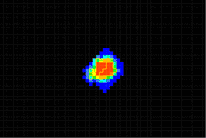French flag model

The French Flag Model is a conceptual definition of a morphogen, described by Lewis Wolpert in the 1960s.[2][3] A morphogen is rigorously defined as a signaling molecule that acts directly on cells (not through serial induction) to produce specific cellular responses dependent on morphogen concentration. During early development, morphogen gradients generate different cell types in distinct spatial order.
In the French flag model, the French flag is used to represent the effect of a morphogen on cell differentiation: a morphogen affects cell states based on concentration, these states are represented by the different colors of the French flag: high concentrations activate a "blue" gene, lower concentrations activate a "white" gene, with "red" serving as the default state in cells below the necessary concentration threshold.
The French Flag model was championed by the leading Drosophila biologist, Peter Lawrence. Christiane Nüsslein-Volhard identified the first morphogen, Bicoid, one of the transcription factors present in a gradient in the Drosophila syncytial embryo. Two labs, that of Gary Struhl and that of Stephen Cohen, then demonstrated that a secreted signaling protein, Decapentaplegic (the Drosophila homologue of Transforming Growth Factor Beta), acted as a morphogen during later stages of Drosophila development. substance governing the pattern of tissue development and, in particular, the positions of the various specialized cell types within a tissue. It spreads from a localized source and forms a concentration gradient across a developing tissue.
Well-known morphogens include: Decapentaplegic / Transforming growth factor beta, Hedgehog / Sonic Hedgehog, Wingless / Wnt, Epidermal growth factor, and Fibroblast growth factor.
Some of the earliest and best-studied morphogens are transcription factors that diffuse within early Drosophila melanogaster (fruit fly) embryos. However, most morphogens are secreted proteins that signal between cells.
Morphogens are defined conceptually, not chemically, so simple chemicals such as retinoic acid may also act as morphogens.
References
- ↑ Knabe J.F, et al. (2008). "Evolution and Morphogenesis of Differentiated Multicellular Organisms: Autonomously Generated Diffusion Gradients for Positional Information". Artificial Life XI: Proceedings of the Eleventh International Conference on the Simulation and Synthesis of Living Systems.
- ↑ Wolpert L (October 1969). "Positional information and the spatial pattern of cellular differentiation". J. Theor. Biol. 25 (1): 1–47. doi:10.1016/S0022-5193(69)80016-0. PMID 4390734.
- ↑ Wolpert, Lewis; et al. (2007). Principles of development (3rd ed.). Oxford [Oxfordshire]: Oxford University Press. ISBN 0-19-927536-X.
External links
Excellent resources for further study of this topic include:
- Interactive Fly
- Flybase
- Artificial Life model of multicellular morphogenesis with autonomously generated gradients for positional information
NCBI resources
From the National Center for Biotechnology Information: